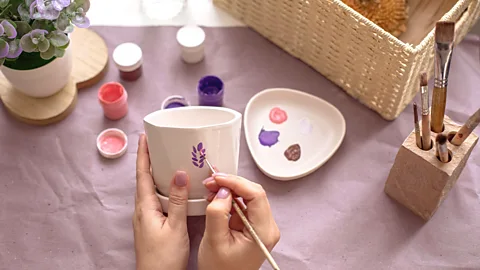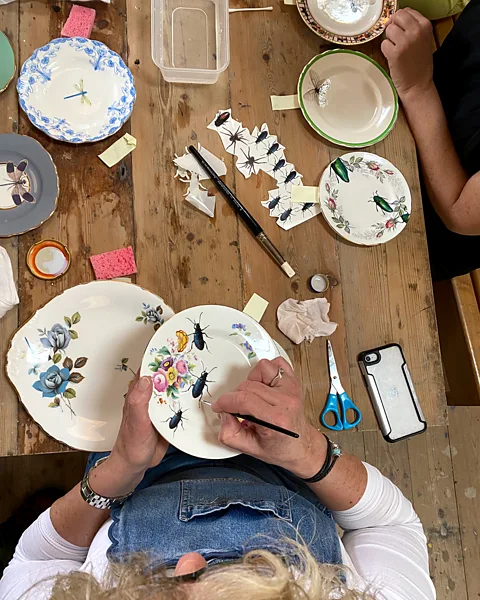How releasing our 'inner artist' can help keep us calm
 Alamy
AlamyFrom "craftivism" to easy, imaginative upcycling, being creative can bring a sense of peace – and quell the urge to acquire more and more stuff.
Designer Lou Rota started upcycling some years ago. "I'd walk past a salvage shop and there were always teetering piles of those ubiquitous stacking chairs which, while a great shape as per the original design by Robin Day, were often in uninspiring shades of grey or brown," she tells the BBC. "I bought a few and proceeded to experiment by sanding them down, and covering them in strips of the Financial Times." The newspaper's "pleasing shade of plaster pink" became a backdrop for motifs that Rota made using photographs of insects. Before long, the high-end department store Liberty had taken the lot. "There was something very satisfying about seeing a piece on the glamorous shop floor of such a well-known store and knowing that it had been rescued from a skip," says Rota.
 Lou Rota
Lou RotaRota is just one of a growing number of artists finding new ways to make use of discarded items. In the book Broken: Mending and Repair in a Throwaway World, craft and circularity expert Katie Treggiden profiles 28 artists, curators, menders and remakers who celebrate care and repair: from Linda Brothwell, a Bristol-based artist who started her art career by darning and embroidering upholstered seats taken from the London Underground, and Aono Fumiaki, who created installations from debris gathered from tsunami-hit cities, to former nurse Celia Pym, who hand darns humble items such as paper bags and tracksuits. Now, their work is playing into broader narratives around over-consumption – and posing the question: could creativity be our way to stop shopping?
The past few years have seen research that lays the charge of the changing climate firmly at the feet of modern society, in which shopping has become a primary leisure activity. When public interest think tank Hot or Cool published 1.5-Degree Lifestyles: Towards a Fair Consumption Space for All (2021), it quoted findings by Oxfam that to limit global heating to 1.5C, "the per capita consumption emissions of the richest 10% of the global population should be reduced to about a tenth of their current level" (it added that those of the poorest 50% could still increase in order to meet basic needs). In this context, re-use and repair take on new meaning, and skills like Rota's, Brothwell's, Fumiaki's and Pym's – already important – will be even more needed.
 Alamy
AlamyWhen Hot or Cool focused on the industry a year later, in its follow-up report Unfit, Unfair, Unfashionable: Resizing Fashion for a Fair Consumption Space, it recommended that everyone reduce their fashion consumption to just five pieces a year. For an industry that churns out more than 100 billion items a year and throws most of that into landfill or incineration after a few uses, that's quite the challenge. It's little wonder that it is in fashion where so much innovative work is taking place to recapture lost fibres and fabrics, drawing from the materials at hand for inspiration. Artists such as Helen Kirkum reimagine waste as primary and precious materials to create artisanal sneakers; Worn To Threads creates beautiful embroidered pieces from upcycled materials and offcuts.
Meanwhile Elvis & Kresse make bags and homeware from 15 different reclaimed materials, while bespoke tailor Sarah Hollebon repurposes garments, to create campaigns around issues such as mental health with other artists and charities. "We've been living in a time when most of our work happens in our heads – and there's something somatically disjointed about that which we're trying to reclaim with crafts," reflects climate activist Daze Aghaji. "People are returning to the idea of the labour of love. They want to garden, they want to be closer to nature, they want to learn to upcycle their clothing. In the UK, which has such a rich history in Arts and Crafts, we can think about craft not just as a replacement for consumerism but as a way of re-connecting with nature and of practising that connection in a very tangible, body-led way."
More like this:
Rota, who runs upcycling workshops, and designs ceramics for Anthropologie and Duchess China, adds: "I'm deeply encouraged by how mending and repair – like darning, the art of kintsugi or ceramic repair – are becoming art forms in their own right. By celebrating imperfection and the inherent history of a piece perhaps we can start to change our relationships with objects, materials and the planet's finite resources."
 Elvis & Kresse
Elvis & KresseTop tip? Start small, says Rota. "Raid family cupboards for vintage plates or source from a car boot [sale]. Decorate them with cut-out images from gardening magazines or old field guides. Use a decoupage or PVA glue to stick them on (careful not to use too much, or it will smear) and then carefully paint a coat on top to seal. They make great presents, particularly if the china holds memories." Others are using their crafting skills to make a statement, for example protesting against fast fashion, giving rise to a global craftivist movement of "gentle activism".
Another tip is to use what you already have. Mary Morton runs a group called the Edinburgh Street Stitchers, volunteers who sit in the parks and streets of Edinburgh, and offer advice on repairing the clothes to passers-by. When she appeared on BBC Radio 4 Woman's Hour recently, this was her first piece of advice: "Many people have a wardrobe full of clothes and they'll never wear half of them. I did what they call 'shopping in your own wardrobe'. If I had two T-shirts that were very similar, I’d put one aside. If I feel like something fresh, I can go to the pile of items I've put aside." Morton has not bought clothes for five years after becoming concerned about the impact of textiles on the environment.
Stepping back from your next impulse purchase starts by asking yourself why you want it in the first place. Aghaji used to shop fast fashion "because I was so depressed about the climate crisis, and I'd think, I need a treat," she says. "A large part of consumerism is fuelled by the fact that we're deeply unhappy. Often, [shopping] is about finding ways to make ourselves feel whole again." Turning down the white noise of social media will help. In the now seminal text Less is More: How Degrowth will save the World, ecological economist Jason Hickel turns a highly critical eye to the vehicles that create and reinforce a narrative of consumption.
The power of imagination
Of course, creativity comes in all forms. If – as author Amitav Ghosh has claimed – the climate crisis is a crisis of the imagination, then creativity could be its most robust retort.
"In a lot of my work, I talk about culture shift and narrative change," says systems thinker Rachel Arthur. "Sustainability can feel very technical, or it's talked about through a lens of sacrifice, doom and gloom, reduction. Much of that is necessary but what we also need are storytellers who can shape a vision of a sustainable future. If we want change to happen, we have to be able to imagine what that world looks like."
 Darren Washington
Darren WashingtonIn fashion, one of the most recent examples of this is the Fashion Fictions project by Professor Amy Twigger Holyroyd, in which participants are invited to dream up visions of alternative fashion cultures, no matter how improbable they might sound. Imagine worlds in which images cannot be shared on the internet, people embrace stains, "dandy grannies" are key fashion influencers, and refugee communities generate revolutionary new fashion systems.
Tips to channel your creativity
1. Use what you already have as creatively as you can.
2. Start small, play, embrace imperfections, and keep practising.
3. Follow your passions. Adore animals or plants? Find motifs to transfer on to old T-shirts, vintage plates or furniture.
4. Question new purchases by reading up on how they're made.
"The rise in popularity of crafting – making something tangible with your hands – also strikes me as a good antidote for social media, where hours are potentially wasted scrolling with nothing to see for your time," continues Rota. "Our concentration levels can be pretty shot and there's something deeply pleasing and soothing about the focus, physical process and the end product, particularly when you’re simply using existing materials rather than adding to the mass of stuff already out there. Once people realise how easy it is to make something relatively impressive, no matter how 'arty' they may or may not be, you can really see them get the upcycling-and-crafting bug."
Arthur adds: "I look at what's happening in local communities, to find out whether they're starting to think about these things – and they are," Aghaji agrees: "Once we start to look at our lives and find alignment and purpose, and all these things we can learn via the understanding of craft, we can find ways to feel happy and fulfilled that aren’t aligned with material goods. To be able to have a lot less – but have more at the same time. We're walking into a time when we have to be the creators, we have to be the imaginaries, and it’s extremely grounding to create something, and know you’re playing a part in this."
--
If you liked this story, sign up for The Essential List newsletter – a handpicked selection of features, videos and can't-miss news, delivered to your inbox twice a week.
